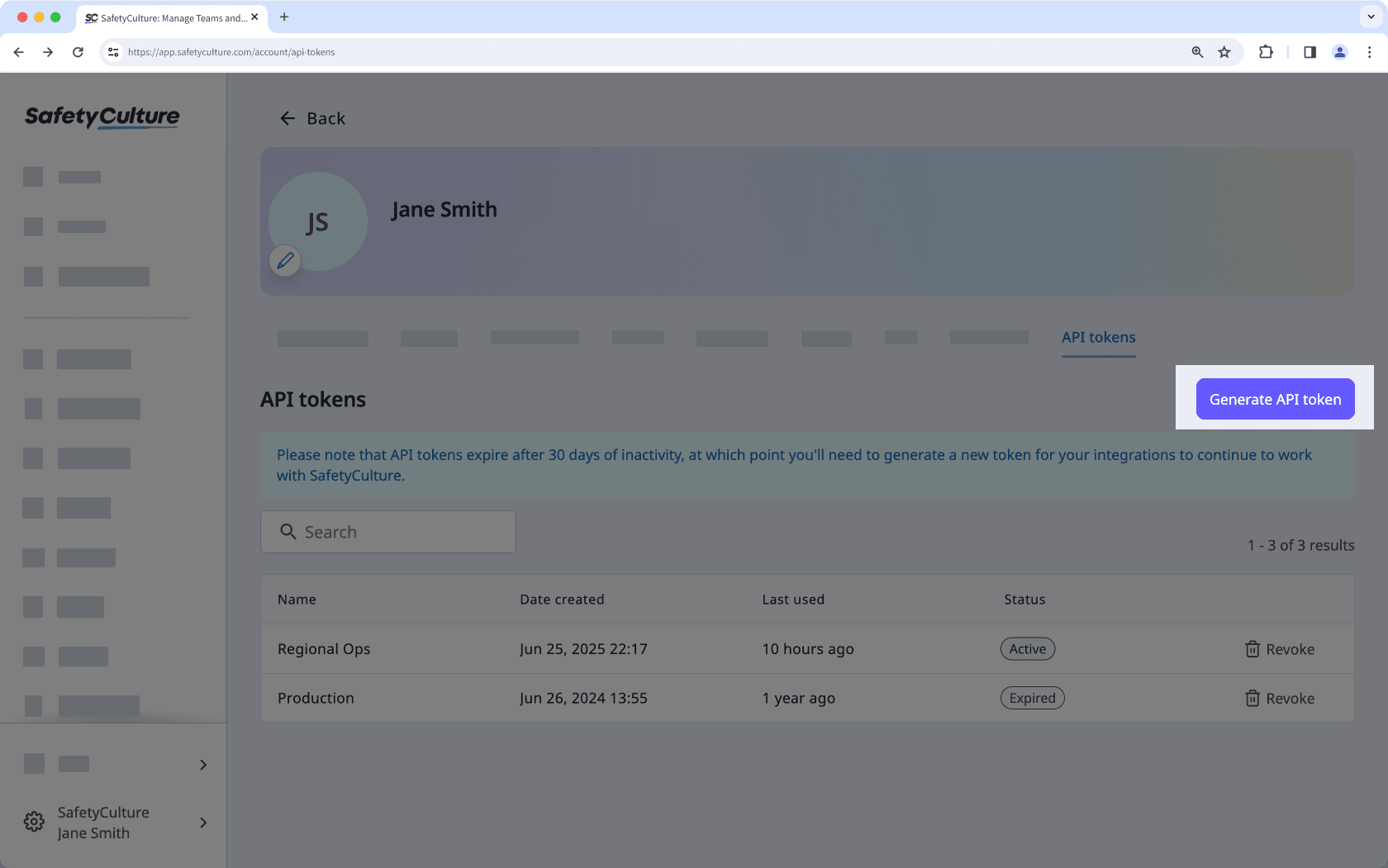- Integraciones
- Integración personalizada
- Generar token de API
Generar token de API
Este artículo le enseña cómo generar tokens para API que son necesarios para integraciones con SafetyCulture.What are the differences between service user and user API tokens?
Service user and user API tokens offer flexible ways to connect external tools to SafetyCulture.
Service user API tokens are best suited for long-term or shared integrations where access should stay the same regardless of user changes. You can set their permissions, which makes them ideal for stable, system-level connections.
User API tokens are suitable for one-off tasks, personal workflows, or scenarios where access needs to reflect a specific user's permissions or group and site memberships.
Choosing the correct token type ensures your integration runs smoothly while matching your organization's security and access needs.
Functionality | Service user API token | User API token |
|---|---|---|
Ownership | Created for a service user (system-based or integration-focused) | Created by an individual user |
Login | Cannot be used to log in | Can be used to log in |
Permissions | Assigned for each service user | Inherits the user’s permission set |
Group and site access control | Not supported | Inherits access from the user |
Integrations | Designed for long-term or shared integrations | Suited for short-term or personal use |
Token stability | Not affected by user changes | Will expire if user is deactivated or exits the organization |
Activity logs | Shows the service user name | Shows the individual user’s name |
Visibility | Not shown in the user list | Visible in user settings |
Billing | Does not count toward seat billing | Counts toward assigned user seat |
Each user can create up to 10 active user API tokens. Whereas, each organization can have up to 20 active service user tokens.
If you belong to multiple organizations, you need to create separate API tokens for your integrations. This applies to both service user and user API tokens.
Tenga en cuenta que los tokens de API caducan después de 30 días de inactividad, momento en el cual deberá generar un nuevo token para que sus integraciones continúen funcionando con SafetyCulture.
If your organization uses single sign-on (SSO) and does not allow non-SSO logins, you may not be prompted to enter a password when you generate a new user API token.
Generar un token para API
Haga clic en su nombre de usuario en la esquina inferior izquierda de la página y seleccione Mi perfil.
Haga clic en
Ajustes en la parte superior derecha de la página.
Seleccione Tokens de API en la parte superior derecha de la página.
Haga clic en Generar token de API en la parte superior derecha de la página.

En la ventana emergente, asigne un nombre al token e introduzca la contraseña de su cuenta. Si su organización utiliza el inicio de sesión único (SSO) y no permite inicios de sesión sin SSO, no debería tener que introducir una contraseña.
Haga clic en Generar.
Haga clic en el token recién generado para copiarlo en su portapapeles. Asegúrese de almacenar el token de forma segura, ya que no podrá volver a verlo una vez que cierre la ventana emergente.
Revocar un token para API
Haga clic en su nombre de usuario en la esquina inferior izquierda de la página y seleccione Mi perfil.
Haga clic en
Ajustes en la parte superior derecha de la página.
Seleccione Tokens de API en la parte superior derecha de la página.
Haga clic en
Revocaren el lado derecho del token.
En la ventana emergente, haga clic en Revocarpara confirmar.
Frequently asked questions
It depends on how your integration is set up.
For custom-built integrations (such as Workato, scripts, or direct API calls using a service user or user API token): Yes. Regenerating the token will break the integration until the replacement token is manually updated in your integration settings.
For built-in SafetyCulture integrations (such as Power BI, Microsoft Teams, or SharePoint): No. These integrations use system-managed tokens, so revoking or regenerating your API tokens will not affect them.
Revoking a service user API token immediately stops it from working, but you can still regenerate it later. This is helpful if you want to pause an integration temporarily without removing the token entirely.
Deleting a service user API token permanently removes it from your organization. You can only delete a token after revoking it. Once deleted, the token can't be recovered or regenerated, so you'll need to create a new one if you want to reconnect the integration.
¿Esta página le fue de ayuda?
Gracias por hacérnoslo saber.